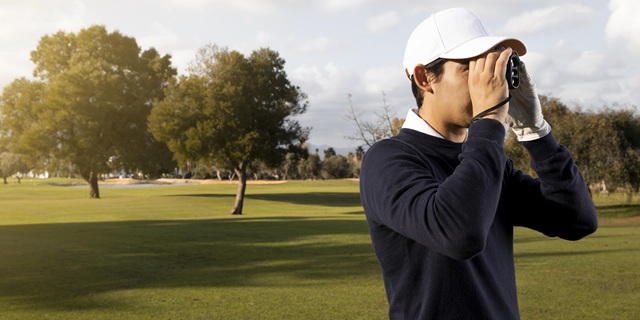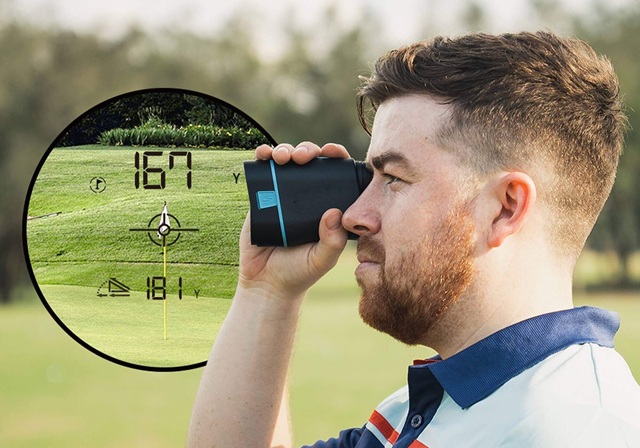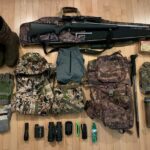Anyone who has picked a club at least once knows how tough and frustrating golf can be. Having the right gear on hand, whether a set of clubs for different distances or comfortable shoes for a four-hour walk, can make a golfer’s life much easier. Additionally, more than being a basic golfing gear, certain devices give the modern golfer a significant edge over those who played before the mid-1990s.

If you wonder what happened then, it was the introduction of the first laser rangefinder. With the help of GPS technology, the laser takes the guesswork out of golf. Although it won’t assure you hit your ball close, knowing how far you’re from the flag will help you use the right club and give you the best chance. What comes next is up to you.
What Does a Range Finder Do?

A golf distance finder is a helpful gadget designed to help the golfer calculate the distance and accuracy of their shot. It produces a laser beam toward a target, such as a flagstick, bunker or other golf course landmark. After hitting the target, the laser bounces back to the rangefinder. The device then measures the time it takes for the laser to reach and return to the target.
Based on this time interval, the rangefinder determines the distance using the speed of light. Everything happens in less than a second. A golf rangefinder with slope will even account for the elevation rise or fall, providing an adjusted yardage. It indicates how much the terrain will impact the distance you must traverse. While most models use a laser to take accurate measurements, some of the best models also have GPS capabilities integrated into the viewfinder or a phone app.
Are Golf Rangefinders Worth It?
Whether you’re a beginner or an experienced player, a golf distance finder is essential to improve your game. Here are five reasons why investing in this gadget is totally worth it:
- It eliminates guesswork. Although using flag markers to determine your target’s range can somewhat help, they don’t provide an accurate reading. A range finder accurately measures the distance between you and the hole, eliminating the guesswork required to know how you should hit the ball. It’ll also help you learn to measure and improve your skill.
- It makes you faster. Sometimes, you have time only for a quick practice on the greens, not a whole day. Knowing that guessing the distance can take up more than half of the game, a laser golf rangefinder is here to save the day (literally).
- It helps you decide which club to use. You must know how far the hole is to know which club to use. That’s not easy, especially if you’re new to the game. A range finder can help you with that.
- It’s easy to use and convenient. If you’re concerned about lugging another piece of equipment, don’t worry. They’re small and compact, adding almost no weight to your load. Some even come with a small, compact case to wear around your wrist or slip into the side of your golf bag.
- It can help improve your overall skills. No matter how experienced a player is, there is always space for skill improvement. A rangefinder can especially enhance your practice.
What to Look for in a Golf Distance Finder?

Precision
This is undoubtedly the most crucial consideration when choosing a rangefinder. If inaccurate, the gadget will provide false information that could cause you to play the wrong club, resulting in a bogey or two. Some inexpensive models can be inconsistent and inaccurate, so be careful about that.
Display
What is the display’s clarity and readability? Some models provide remarkably crisp images, while others have decent displays. In the end, a decent model should feature magnification, clear, bright optics and a display that is easy to read against the background.
Battery Life
It is recommended that you know the type of battery that a specific laser requires. Additionally, consider how many charge cycles the battery is good for, whether it’s rechargeable and how long it lasts on a charge. Lastly, ensure that the rangefinder you’re considering doesn’t require a unique battery type that is costly or hard to find.
Slope
Would you like slope measurements in your model? If so, review several models’ technical characteristics. Always exercise caution, though, as using a model in competition could land you in hot water if it is unclear whether it is in slope mode.
Waterproofing
This is crucial since a high-quality model will function as effectively in the rain as in the sun. Researching which models are completely waterproof or only water-resistant is advised in this case, since it can make a significant difference, especially if you frequently play golf in the rain.
Protection
We all drop things occasionally, so decent rangefinders need to be able to withstand a drop or two. Opt for an impact-resistant model. Also, check if the laser comes in a case. Many models now come with sturdy cases that easily attach to your golf bag.
Practicality
With convenience, rangefinders must be quick and simple to operate. Remove it, measure the flag and then store it in its case. A laser adds time instead of saving it if it is difficult to use or takes a long time to display a measurement.
Looks
Even though the other factors are more important, you should still appreciate how your rangefinder looks because nobody wants a large, unsightly item connected to their luggage, right?
Magnet Mount
Would you like your rangefinder to include magnetic components so you can simply fasten it to your cart instead of constantly taking it out of its case? If so, look for models including a magnet mount.
Alternatives: What is Better, Golf GPS or Rangefinder?
Golf watches and GPS handheld devices are the alternatives for a distance finder. There are certain benefits of using these over a rangefinder, such as a cut price and fast response even when the target isn’t visible. Yet, most elite players won’t rely on a golf GPS. They like to use a rangefinder because they need the most accurate yardage information.





















